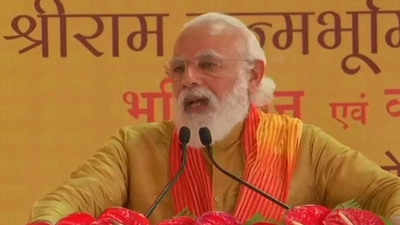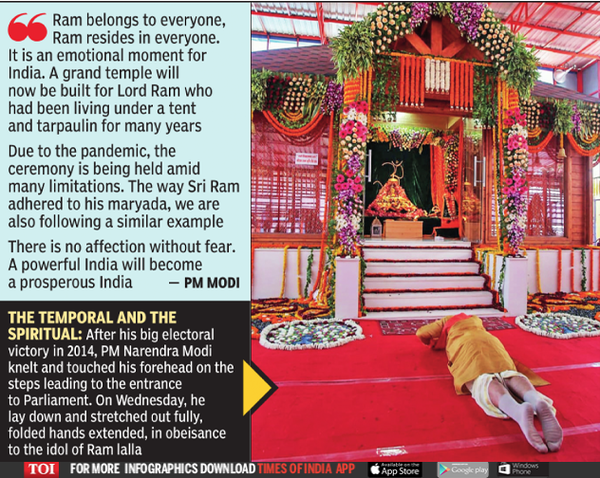- News
- India News
- At bhoomi pujan, PM Modi likens mandir campaign to freedom movement
Trending
This story is from August 6, 2020
At bhoomi pujan, PM Modi likens mandir campaign to freedom movement
Prime Minister Narendra Modi on Wednesday dedicated the Ram Mandir to the struggle and sacrifice of hundreds of kar sevaks, drawing a parallel between the campaign for construction of the temple in Ayodhya with the struggle for India’s independence.

ANI photo.
AYODHYA: Prime Minister Narendra Modi on Wednesday dedicated the Ram Mandir to the struggle and sacrifice of hundreds of kar sevaks, drawing a parallel between the campaign for construction of the temple in Ayodhya with the struggle for India’s independence.
Speaking after performing ‘bhoomi pujan’ at the Ram Janmabhoomi site to herald the beginning of construction, the PM said the occasion marked the end of centuries-long wait for a Ram Mandir and saluted those whose struggle and resolve “laid the foundation stone” for the temple.
“Ramji, who for years was consigned to a tent, has finally been liberated from the cycle of destruction and construction. During our freedom movement, many generations sacrificed all that they had. The period of foreign occupation saw ceaseless striving for independence and there was no part of the country which did not witness sacrifice for the sake of freedom. August 15 symbolises the commitment, the struggle, the endless sacrifices as well as the indefatigable spirit for freedom. Just like that, today’s date symbolises the commitment, sacrifice and resolve of several generations who through centuries struggled relentlessly for Ram Mandir with single-minded resolve,” Modi said. “Millions will find it hard to believe that they are actually witnessing the realisation of their dream,” he added.

In his speech punctuated with quotes from Tulsidas’s Ramayan, Modi emphasised the centrality of Lord Ram to Indian culture and ethos, saying he remained an integral and inalienable part of India, defying the efforts to eradicate his existence.
“Ram is etched in our souls, we have internalised him, everybody looks up to him. Look at the amazing strength of Lord Ram, buildings were destroyed, no effort was spared to eradicate his existence. Still, Ram resides in our hearts, he is the basis of our culture, he represents Indian virtues; indeed, he is Maryada Purushottam,” Modi said in what was seen as a reference to the belief that the Ram Mandir in Ayodhya was destroyed by the Mughals, as well as the assertion of some historians that Ramayan and its hero were myths.
“It is against this background that ‘bhoomi pujan’ has been done for the grand temple of Ram Janmabhoomi. It will be a modern representation of our culture. It will be the symbol of our eternal faith, of our nationalist feeling, and this temple will represent the collective resolve of millions and millions of devotees. This will inspire the coming generations,” Modi said.
Just as popular support for Mahatma Gandhi fuelled the freedom movement, this day would not have been possible without people’s support, Modi said, stressing that shilaas (pillars) had become a source of energy. “The strength shown by people in the Ram temple movement is a subject of research,” he added.
“This moment will keep India’s glory intact for several centuries, this is a symbol of the resolve and willpower of crores of Ram bhakts, truth and non-violence, a tribute of law-abiding India. History is not being re-enacted, it is being re-written,” he said.
The PM said his choice of “modern” was deliberate as the Ram Mandir, which will be visited by devotees from across the globe, will transform Ayodhya’s economy — a remark which appeared to allude to the Sangh Parivar's ambition to develop the city into a vast religio-cultural complex along the lines of Vatican City.
Modi also sought to contradict the depiction of Ram in certain quarters as a phenomenon confined to Hindus of the Hindi belt and as a patriarchal figure. He referred to versions of Ramayan in all Indian languages, including one written by Guru Gobind Singh, as well as the popularity of the epic in Indonesia, home to the single largest concentration of Muslims; Malaysia, another predominantly Muslim country; as well as Ajmer, the site of a revered Sufi shrine besides the Muslim-majority Union Territory of Lakshadweep. “Ram belongs to all, Ram lives in all,” he said.
“The slogan of Jai Sri Ram is reverberating in the entire world. Ram bhakts are rejoicing and feeling proud to be part of the occasion. Many would be surprised and happy at the same time to be part of this moment,” he added.
Modi referred to non-Savarna figures in Ramayan, from forest-dweller Shabari to the boatman, and said Ayodhya was a holy place also for Buddhists, Jains and Sikhs. He added that Lord Ram had social solidarity as the foundational principle of his Ram Rajya. In the same vein, Modi said as a ruler, Lord Ram did not discriminate among his people, but gave special attention to the poor. He claimed that the Supreme Court verdict had found universal acceptance, with people observing “maryada”.
In what appeared to reflect the Sangh Parivar's desire to consolidate Hindus, Modi talked about people from Maharashtra's Malwan region who were crucial in Shivaji's military successes, the cowherds associated with Lord Krishna and the OBCs and the poor who helped subaltern hero Suheldev fight off the foreign invader.
Speaking after performing ‘bhoomi pujan’ at the Ram Janmabhoomi site to herald the beginning of construction, the PM said the occasion marked the end of centuries-long wait for a Ram Mandir and saluted those whose struggle and resolve “laid the foundation stone” for the temple.
“Ramji, who for years was consigned to a tent, has finally been liberated from the cycle of destruction and construction. During our freedom movement, many generations sacrificed all that they had. The period of foreign occupation saw ceaseless striving for independence and there was no part of the country which did not witness sacrifice for the sake of freedom. August 15 symbolises the commitment, the struggle, the endless sacrifices as well as the indefatigable spirit for freedom. Just like that, today’s date symbolises the commitment, sacrifice and resolve of several generations who through centuries struggled relentlessly for Ram Mandir with single-minded resolve,” Modi said. “Millions will find it hard to believe that they are actually witnessing the realisation of their dream,” he added.

In his speech punctuated with quotes from Tulsidas’s Ramayan, Modi emphasised the centrality of Lord Ram to Indian culture and ethos, saying he remained an integral and inalienable part of India, defying the efforts to eradicate his existence.
“Ram is etched in our souls, we have internalised him, everybody looks up to him. Look at the amazing strength of Lord Ram, buildings were destroyed, no effort was spared to eradicate his existence. Still, Ram resides in our hearts, he is the basis of our culture, he represents Indian virtues; indeed, he is Maryada Purushottam,” Modi said in what was seen as a reference to the belief that the Ram Mandir in Ayodhya was destroyed by the Mughals, as well as the assertion of some historians that Ramayan and its hero were myths.
“It is against this background that ‘bhoomi pujan’ has been done for the grand temple of Ram Janmabhoomi. It will be a modern representation of our culture. It will be the symbol of our eternal faith, of our nationalist feeling, and this temple will represent the collective resolve of millions and millions of devotees. This will inspire the coming generations,” Modi said.
Just as popular support for Mahatma Gandhi fuelled the freedom movement, this day would not have been possible without people’s support, Modi said, stressing that shilaas (pillars) had become a source of energy. “The strength shown by people in the Ram temple movement is a subject of research,” he added.
“This moment will keep India’s glory intact for several centuries, this is a symbol of the resolve and willpower of crores of Ram bhakts, truth and non-violence, a tribute of law-abiding India. History is not being re-enacted, it is being re-written,” he said.
The PM said his choice of “modern” was deliberate as the Ram Mandir, which will be visited by devotees from across the globe, will transform Ayodhya’s economy — a remark which appeared to allude to the Sangh Parivar's ambition to develop the city into a vast religio-cultural complex along the lines of Vatican City.
Modi also sought to contradict the depiction of Ram in certain quarters as a phenomenon confined to Hindus of the Hindi belt and as a patriarchal figure. He referred to versions of Ramayan in all Indian languages, including one written by Guru Gobind Singh, as well as the popularity of the epic in Indonesia, home to the single largest concentration of Muslims; Malaysia, another predominantly Muslim country; as well as Ajmer, the site of a revered Sufi shrine besides the Muslim-majority Union Territory of Lakshadweep. “Ram belongs to all, Ram lives in all,” he said.
“The slogan of Jai Sri Ram is reverberating in the entire world. Ram bhakts are rejoicing and feeling proud to be part of the occasion. Many would be surprised and happy at the same time to be part of this moment,” he added.
Modi referred to non-Savarna figures in Ramayan, from forest-dweller Shabari to the boatman, and said Ayodhya was a holy place also for Buddhists, Jains and Sikhs. He added that Lord Ram had social solidarity as the foundational principle of his Ram Rajya. In the same vein, Modi said as a ruler, Lord Ram did not discriminate among his people, but gave special attention to the poor. He claimed that the Supreme Court verdict had found universal acceptance, with people observing “maryada”.
In what appeared to reflect the Sangh Parivar's desire to consolidate Hindus, Modi talked about people from Maharashtra's Malwan region who were crucial in Shivaji's military successes, the cowherds associated with Lord Krishna and the OBCs and the poor who helped subaltern hero Suheldev fight off the foreign invader.
End of Article
FOLLOW US ON SOCIAL MEDIA










